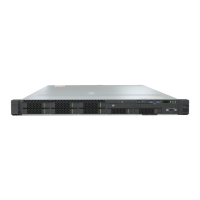− RDIMM and LRDIMM support
− Max. 3200 MT/s memory speed
− The DDR4 memory modules of different types
(RDIMM and LRDIMM) and specifications (capacity,
bit width, rank, and height) cannot be used together.
− A server must use DDR4 memory modules of the same
part number (P/N code).
⚫
Up to 16 PMem modules
− The PMem modules must be used with the DDR4
memory modules, and only one PMem module can be
installed in each memory channel.
− The PMem modules support the AD or MM mode.
− Max. 3200 MT/s memory speed
− The PMem modules of different specifications (capacity
and rank) cannot be used together.
− For details about the PMem modules, see FusionServer
PMem 200 User Guide.
NOTE
The preceding information is for reference only. For details, see
"Search Parts" in the Compatibility Checker.
Supports a variety of drive configurations. For details, see
5.5.1 Drive Configurations .
⚫
Supports two M.2 SSDs.
− M.2 SSDs are supported for RAID configuration when
the server is configured with an Avago SAS3004iMR
RAID controller card.
NOTE
⚫
The M.2 SSD is used only as a boot device for installing the OS.
Small-capacity (32 GB or 64 GB) M.2 SSDs do not support
logging due to poor endurance. If a small-capacity M.2 SSD is
used as the boot device, a dedicated log drive or log server is
required for logging. For example, you can dump VMware logs in
either of the following ways:
⚫
Redirect /scratch. For details, see
https://kb.vmware.com/s/article/1033696.
⚫
Configure syslog. For details, see
https://kb.vmware.com/s/article/2003322.
⚫
The M.2 SSD cannot be used to store data due to poor endurance.
In write-intensive applications, the M.2 SSD will wear out in a
short time.
If you want to use SSDs or HDDs as data storage devices, use
enterprise-level SSDs or HDDs with high DWPD.
⚫
The M.2 SSD is not recommended for write-intensive service
software due to poor endurance.
⚫
Do not use M.2 SSDs for cache.
⚫
Supports hot swap of SAS/SATA/NVMe U.2 drives.
NOTE

